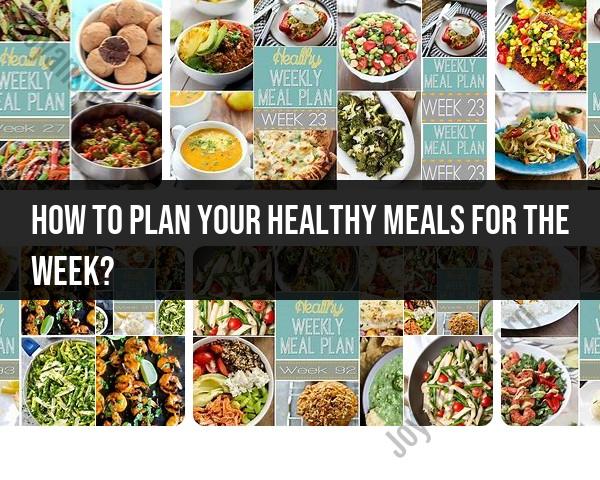How to plan your healthy meals for the week?
Planning your meals for the week is a proactive approach to ensure you're making healthier choices and sticking to your nutritional goals. Here's a step-by-step guide to help you plan your weekly meals in a healthy and balanced way:
1. Assess Your Goals and Dietary Needs:
- Consider your health goals, whether it's weight loss, maintenance, muscle gain, or specific dietary requirements.
- Take note of any dietary restrictions or preferences.
2. Create a Weekly Schedule:
- Use a calendar or planner to map out your week.
- Identify busy days or nights when you may need quick and easy meals.
3. Build a Balanced Plate:
- Include a variety of food groups in each meal:
- Proteins: Lean meats, fish, poultry, tofu, legumes.
- Carbohydrates: Whole grains, fruits, vegetables.
- Healthy Fats: Avocado, nuts, seeds, olive oil.
- Dairy or Alternatives: Milk, yogurt, cheese.
4. Plan Your Meals:
- Start by planning dinners and then build around them.
- Use theme nights to simplify planning (e.g., Meatless Monday, Taco Tuesday).
- Consider leftovers for lunch the next day.
5. Batch Cooking:
- Prepare larger quantities of staple ingredients like grains, proteins, and vegetables to use in multiple meals throughout the week.
- This can save time and ensure you always have nutritious options available.
6. Incorporate a Variety of Foods:
- Include a mix of colors, textures, and flavors to make your meals more enjoyable.
- Rotate through different vegetables, proteins, and grains to ensure a diverse nutrient intake.
7. Portion Control:
- Be mindful of portion sizes to avoid overeating.
- Use smaller plates to help control portion sizes visually.
8. Snack Planning:
- Plan for healthy snacks to keep you satisfied between meals.
- Have readily available options like cut-up fruits, vegetables, yogurt, or nuts.
9. Hydration:
- Include water, herbal teas, or other low-calorie beverages in your plan.
- Limit sugary drinks and be mindful of alcohol consumption.
10. Grocery Shopping:
- Create a shopping list based on your meal plan.
- Stick to the list to avoid impulse purchases.
11. Prep Ahead:
- Wash, chop, and portion fruits and vegetables for easy access.
- Precook grains, proteins, or sauces for quick assembly during the week.
12. Flexibility:
- Allow for flexibility in your plan for unexpected events or social occasions.
- Learn to adapt and make healthier choices when dining out.
13. Reflect and Adjust:
- At the end of the week, reflect on what worked well and what could be improved.
- Adjust your plan based on your experiences.
14. Seek Professional Guidance:
- Consult with a registered dietitian or nutritionist for personalized advice based on your health goals and needs.
By taking a systematic approach to meal planning, you can establish a sustainable routine that supports your health and nutrition goals. Tailor these steps to fit your lifestyle and preferences, and don't hesitate to experiment with new recipes and ingredients to keep your meals exciting and satisfying.
Planning Healthy Meals for the Week: A Complete Guide
1. Plan with Purpose:
- Consider your needs and preferences: Do you have dietary restrictions? How much time do you have for cooking?
- Set realistic goals: Aim for balanced and nutritious meals without overwhelming yourself.
- Utilize the MyPlate guidelines: Fill half your plate with vegetables, a quarter with protein, and a quarter with whole grains.
- Schedule your meals: Plan what you'll eat for breakfast, lunch, dinner, and snacks throughout the week.
2. Meal Prepping Strategies:
- Cook in bulk: Double or triple recipes during the weekend for easy reheating throughout the week.
- Chop and store vegetables: Pre-cut veggies for salads, stir-fries, or snacks to save time.
- Cook grains in advance: Prepare quinoa, brown rice, or other grains to quickly add to meals.
- Portion out snacks: Avoid overeating by pre-packaging yogurt, nuts, or fruit into individual containers.
- Make healthy swaps: Opt for lean protein, whole grains, and healthy fats like olive oil.
3. Tools and Resources:
- Online recipe websites and apps: Find countless healthy and delicious recipes, many with meal planning features.
- Grocery delivery services: Save time and effort by ordering ingredients online for pick-up or delivery.
- Meal planning tools and templates: Several websites and apps offer templates and guidance for planning your meals.
- Cookbooks and magazines: Explore healthy recipe collections for inspiration and ideas.
- Registered Dietitians (RDs): Consult an RD for personalized meal plans and nutrition advice.
Bonus Tips:
- Involve the family: Get everyone involved in meal planning and preparation to make it a fun activity.
- Keep it simple: Don't overcomplicate your meals. Use basic ingredients and focus on variety and balance.
- Leftovers are your friend: Plan meals that can be easily repurposed for lunch or dinner the next day.
- Don't forget to enjoy your food! Eating healthy should be a positive and satisfying experience.
Remember, meal planning is a skill that takes practice. Start small, make adjustments as needed, and don't be afraid to experiment until you find a system that works for you!
I hope these tips and resources help you create healthy and enjoyable meals for the whole week!












